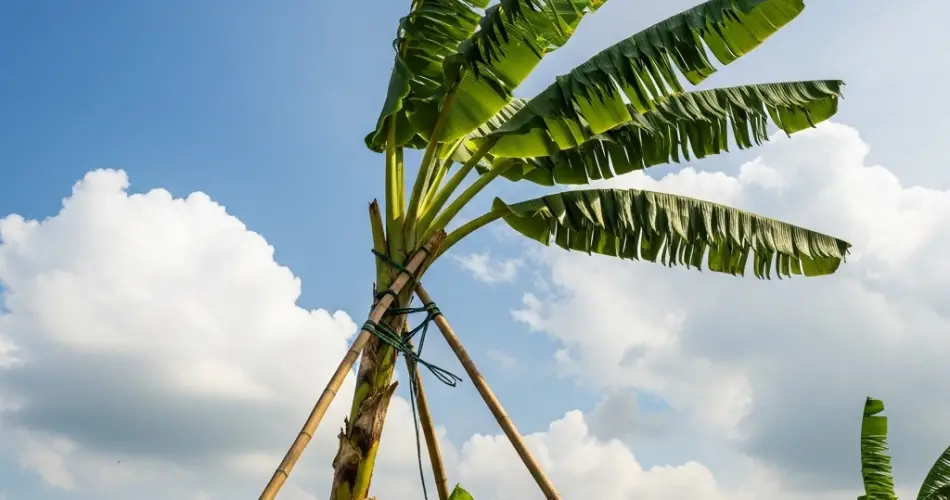Banana trees are known for their large, lush leaves and tall, elegant form, but these very characteristics make them vulnerable to strong winds. While banana plants can grow quickly and thrive in warm, humid climates, their shallow roots and delicate leaves mean they need protection from harsh weather. Without adequate wind protection, banana trees can suffer broken leaves, snapped stems, or even be uprooted. Fortunately, with the right techniques, you can shield your banana trees and keep them healthy and productive even in windy conditions.
Why Wind Protection Is Important for Banana Trees
Banana plants grow fast and can reach up to 10 to 20 feet tall depending on the variety. Their pseudostems (which look like trunks but are made of tightly layered leaves) are not woody and are relatively soft. Strong winds can:
-
Tear leaves, reducing the plant’s ability to photosynthesize
-
Break or bend stems, especially when bearing fruit
-
Uproot entire plants, especially if soil is saturated and root systems are shallow
-
Affect fruit development, by stressing the plant or knocking immature bananas to the ground
Protecting banana trees from strong winds helps ensure they reach maturity and produce quality fruit.
Choosing the Right Location
The best wind protection starts before planting. Choose a site that offers natural protection from prevailing winds. Consider the following:
-
Plant near buildings, fences, or walls that block wind without casting too much shade.
-
Use a slope or terrain feature as a windbreak. Hillsides or gentle rises can shield banana trees.
-
Avoid exposed ridges or open fields, especially in areas known for high wind speeds.
If you’re already growing bananas in a windy area, additional strategies can help buffer them from damage.
Use Windbreaks
One of the most effective ways to protect banana trees is by installing windbreaks. These can be:
-
Natural: Dense shrubs, tall grass, or trees like bamboo planted upwind from your banana trees. Native hedges are especially good because they adapt well and encourage biodiversity.
-
Artificial: Garden netting, mesh fabric, or slatted fencing installed on stakes around your banana grove. These allow some airflow but reduce wind speed significantly.
A good windbreak should filter, not completely block, the wind. Blocking all wind creates turbulence that can be equally damaging.
Group Banana Plants Together
Banana plants are more stable when grown in groups. Clumping several banana plants close together allows them to support one another, minimizing individual movement during storms. However, make sure the grouping doesn’t become overcrowded. Too much density can reduce airflow and increase disease risk.
Space banana plants about 5 to 6 feet apart to allow both mutual support and adequate air circulation.
Stake Banana Trees
For extra stability, especially during storms or while fruit is maturing, staking is a good option:
-
Use strong bamboo poles or wooden stakes.
-
Drive the stake into the ground about a foot away from the pseudostem.
-
Tie the stem loosely to the stake using soft, flexible ties that won’t cut into the plant.
Do not tie too tightly—allow for some movement so the plant can grow naturally and strengthen its structure.
Mulch and Soil Support
Wind can dry out the soil quickly and destabilize roots. To counter this:
-
Mulch heavily around the base of the banana tree using straw, wood chips, or compost. This protects roots, retains moisture, and reduces erosion.
-
Mound soil slightly at the base of the plant to strengthen root anchorage.
-
Avoid overwatering, which can weaken the grip of the roots in the soil. Aim for consistent moisture, especially in windy, dry conditions.
Prune Strategically
Large banana leaves are often shredded by the wind. While some tearing is normal, heavy damage affects plant health. To manage this:
-
Remove dead or badly torn leaves to reduce surface area exposed to the wind.
-
Avoid pruning too much at once, as bananas need their leaves for energy.
-
If storms are expected, preemptively trim older or very large leaves to reduce wind resistance.
Seasonal Considerations
If you live in a region that experiences seasonal typhoons, hurricanes, or monsoon winds, take extra precautions:
-
Harvest bananas early if a storm is forecast and the fruit is nearly mature.
-
Cut down tall stems that have already fruited to reduce wind exposure.
-
Reinforce all staking and windbreaks before storm season.
Container-grown banana trees can be moved to more sheltered areas when storms are expected. Just ensure they receive enough sunlight in their temporary location.
Conclusion
Protecting banana trees from strong winds is essential to ensure their growth and fruit production. By choosing a good planting site, using natural or artificial windbreaks, grouping plants, staking, and managing soil and pruning, you can significantly reduce the risk of wind damage. With a little planning and maintenance, your banana trees can thrive even in windy conditions, producing beautiful foliage and sweet, delicious fruit year after year.



